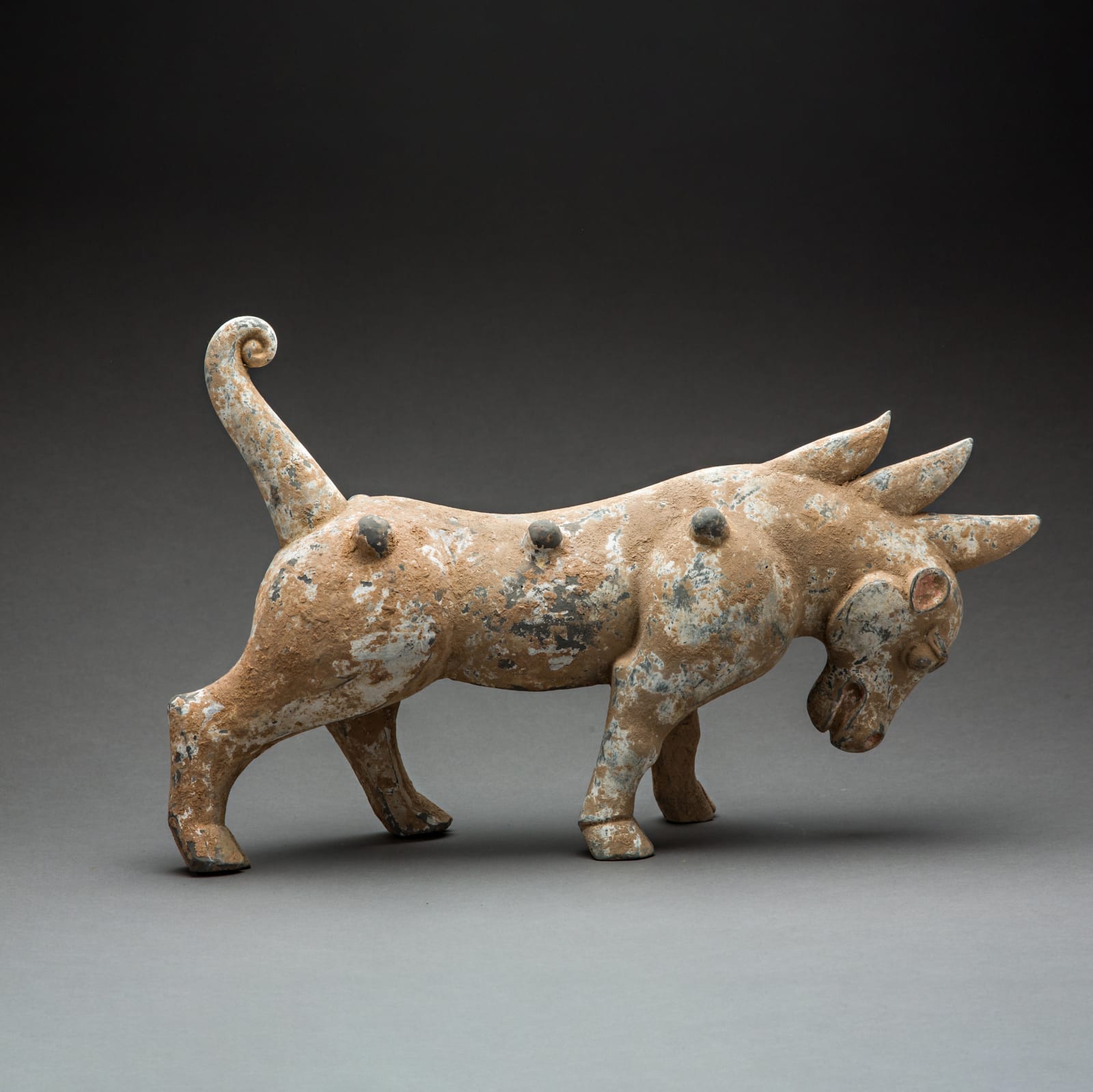Han Dynasty Polychrome Mythical Beast, 206 BC - AD 220
Ceramic, Pigment
25.5 x 11.4 x 40.9 cm
10 x 4 1/2 x 16 1/8 in
10 x 4 1/2 x 16 1/8 in
TF.015
Further images
The sturdy composite horse-like figure with three red-painted spikes and four flattened grey roundels aligned on the spinal cord, the tail curved upwards to form a loop attached on the...
The sturdy composite horse-like figure with three red-painted spikes and four flattened grey roundels aligned on the spinal cord, the tail curved upwards to form a loop attached on the back. The head slightly bent downwards, his equine traits carefully incised and partly in relief.
The menacing expression was in theory meant to serve an apotropaic purpose, perhaps reflecting the northerners’ greater awareness of the dark world of spirits. Yet in this small figurine the fearful expression is absent, instead reflecting perhaps the craftsman's indulgence in a little creative liberty. The sweetness of this animal might betray a southern origin, where tomb guardians dating to the Western Jin onward developed a much more human connotation, when compared with their northern prototypes.
Such a composite animal first emerged during the Western Jin period (265-316) and later evolved in the phantasmagorical human-headed tomb guardians known as earth-spirits (Chin: du sheng), so popular during the Tang dynasty in northern and central China. Instead, in the south, tomb guardians quickly disappeared after the Eastern Jin period (317-420): an abrupt change of practice that probably reflected different cultural approaches. In fact, northern people -being more mindful of spirits and demons- were always more inclined to protect the dead from undesirable encounters and went into a lot of effort in creating wonderful sculptures of tomb guardians; southerners instead simply chose to continue to transmit the age-old practice of providing for the daily life of the deceased in the afterlife.
Clearly, this is a mythological beast. With its head lowered, he appears to charge forward like a pull, thrusting his horns forward into whatever obstacle might block his path. Remnants of the original polychrome pigment are visible throughout the work, including the white slip that once covered the majority of the beast’s body. Rarely do such delicate details survive the ravages of time and the stresses of excavation. A similar example, though lacking the paint details, was unearthed in Yanshi, Henan province in a tomb dated to the western Jin period.
This magnificent sculpture is an insightful glimpse into the fantastic mythology of ancient China.
For an in-depth description of horned tomb guardians see: Fong Mary H., "Tomb Guardians Figurines: Their Evolution and Iconography" in Kuwayama ed, Ancient Mortuary Traditions of China: Papers on Chinese Ceramic Funerary Sculptures, Los Angeles, 1991: 84-115.
The menacing expression was in theory meant to serve an apotropaic purpose, perhaps reflecting the northerners’ greater awareness of the dark world of spirits. Yet in this small figurine the fearful expression is absent, instead reflecting perhaps the craftsman's indulgence in a little creative liberty. The sweetness of this animal might betray a southern origin, where tomb guardians dating to the Western Jin onward developed a much more human connotation, when compared with their northern prototypes.
Such a composite animal first emerged during the Western Jin period (265-316) and later evolved in the phantasmagorical human-headed tomb guardians known as earth-spirits (Chin: du sheng), so popular during the Tang dynasty in northern and central China. Instead, in the south, tomb guardians quickly disappeared after the Eastern Jin period (317-420): an abrupt change of practice that probably reflected different cultural approaches. In fact, northern people -being more mindful of spirits and demons- were always more inclined to protect the dead from undesirable encounters and went into a lot of effort in creating wonderful sculptures of tomb guardians; southerners instead simply chose to continue to transmit the age-old practice of providing for the daily life of the deceased in the afterlife.
Clearly, this is a mythological beast. With its head lowered, he appears to charge forward like a pull, thrusting his horns forward into whatever obstacle might block his path. Remnants of the original polychrome pigment are visible throughout the work, including the white slip that once covered the majority of the beast’s body. Rarely do such delicate details survive the ravages of time and the stresses of excavation. A similar example, though lacking the paint details, was unearthed in Yanshi, Henan province in a tomb dated to the western Jin period.
This magnificent sculpture is an insightful glimpse into the fantastic mythology of ancient China.
For an in-depth description of horned tomb guardians see: Fong Mary H., "Tomb Guardians Figurines: Their Evolution and Iconography" in Kuwayama ed, Ancient Mortuary Traditions of China: Papers on Chinese Ceramic Funerary Sculptures, Los Angeles, 1991: 84-115.







